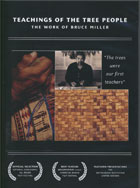
Teachings of the Tree People: The Work of Bruce Miller 2006
Distributed by New Day Films, 190 Route 17M, P.O. Box 1084, Harriman, NY 10926; 888-367-9154 or 845-774-7051
Produced by Islandwood
Directed by Katie Jennings
DVD, color, 58 min.
Jr. High - Adult
American Studies, Anthropology, Biography, Environmental Studies, Multicultural Studies, Native American Studies
Date Entered: 10/26/2007
Reviewed by Meghann Matwichuk, Morris Library, University of DelawareTeachings of the Tree People serves as both an affectionate tribute to a gentle, worldly Native American leader (named a Living Treasure in his home state of Washington) and as an intriguing documentation of the wealth of knowledge one man chose to share over the course of his too-short life. Before his recent passing in 2005, Bruce “Subiyay” Miller was awarded a 2004 National Heritage Fellowship as a ‘tradition bearer’ of the Skokomish people, a coastal Salish tribe located near the Puget Sound. After service in the military during Vietnam and a successful foray into New York City’s theater and arts world during the politically turbulent 70s, Subiyay returned home to his roots to teach Native American arts and crafts to “whoever comes to learn.”
Structured around the passing of the four seasons and composed of striking footage of the Skokomish’s natural habitat, Native American festivities, and daily activities, viewers see the varied and bountiful habitat which inspired Subiyay’s deep attachment to his homeland. Interwoven with this footage are interviews where Subiyay describes his motivations as a teacher and observations about life in the natural world. The audience also hears from his relatives and students, who speak with great pride and affection of their friend and tribal leader. Scholars also speak to his dedication and importance as a mentor and resource for those outside Native American communities.
Subiyay draws eloquent parallels between society’s disconnect from its natural environment and the current state of world affairs. America is, he states, both literally and figuratively a “victim of erosion”—“We’ve lost interest in what the environment has been trying to tell us.” Therefore, as a result of our alienation, the land can no longer provide for us, causing an imbalance in resources which he posits is the root of all war. Despite his physical disabilities (the result of a diabetes-induced stroke), including memory loss, Subiyay dedicated his life to correcting this disparity. Whether through his instruction regarding the medicinal uses of native plants or his communal outreach to school children who are taught to weave bark mats, it’s impossible to deny the impact Subiyay has had on those fortunate enough to come in contact with him.
All of these elements come together to create an appropriate tribute to Subiyay’s never-ending enthusiasm for the skills his ancestors acquired throughout the centuries and his corresponding drive to teach these skills to up and coming generations. Those working with disciplines exploring natural history, environmentalism, community leadership and activism, as well as cultural anthropology and Native American studies will find this warm-hearted production to be a welcome addition to their collections.